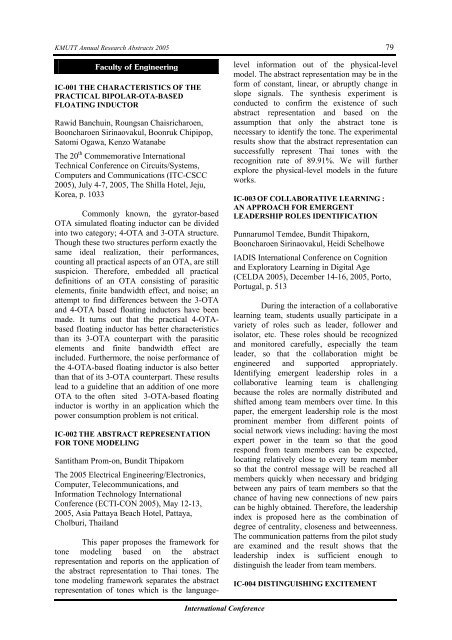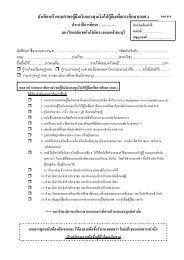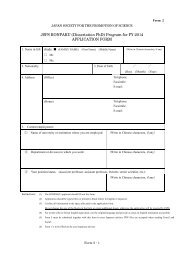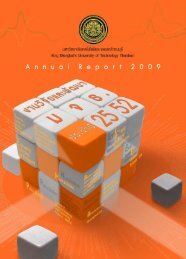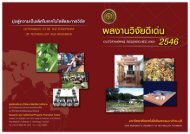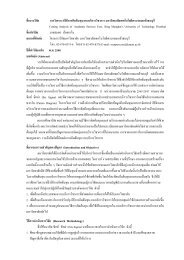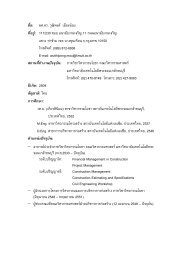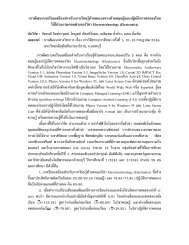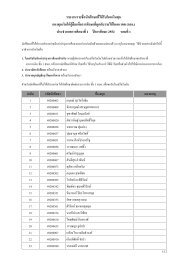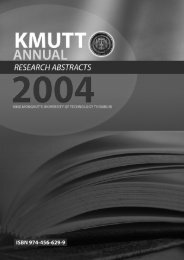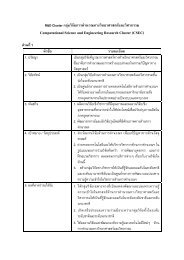You also want an ePaper? Increase the reach of your titles
YUMPU automatically turns print PDFs into web optimized ePapers that Google loves.
KMUTT Annual Research Abstracts 2005<br />
Faculty of Engineering<br />
IC-001 THE CHARACTERISTICS OF THE<br />
PRACTICAL BIPOLAR-OTA-BASED<br />
FLOATING INDUCTOR<br />
Rawid Banchuin, Roungsan Chaisricharoen,<br />
Booncharoen Sirinaovakul, Boonruk Chipipop,<br />
Satomi Ogawa, Kenzo Watanabe<br />
The 20 th Commemorative International<br />
Technical Conference on Circuits/Systems,<br />
Computers and Communications (ITC-CSCC<br />
2005), July 4-7, 2005, The Shilla Hotel, Jeju,<br />
Korea, p. 1033<br />
Commonly known, the gyrator-based<br />
OTA simulated floating inductor can be divided<br />
into two category; 4-OTA and 3-OTA structure.<br />
Though these two structures perform exactly the<br />
same ideal realization, their performances,<br />
counting all practical aspects of an OTA, are still<br />
suspicion. Therefore, embedded all practical<br />
definitions of an OTA consisting of parasitic<br />
elements, finite bandwidth effect, and noise; an<br />
attempt to find differences between the 3-OTA<br />
and 4-OTA based floating inductors have been<br />
made. It turns out that the practical 4-OTAbased<br />
floating inductor has better characteristics<br />
than its 3-OTA counterpart with the parasitic<br />
elements and finite bandwidth effect are<br />
included. Furthermore, the noise performance of<br />
the 4-OTA-based floating inductor is also better<br />
than that of its 3-OTA counterpart. These results<br />
lead to a guideline that an addition of one more<br />
OTA to the often sited 3-OTA-based floating<br />
inductor is worthy in an application which the<br />
power consumption problem is not critical.<br />
IC-002 THE ABSTRACT REPRESENTATION<br />
FOR TONE MODELING<br />
Santitham Prom-on, Bundit Thipakorn<br />
The 2005 Electrical Engineering/Electronics,<br />
Computer, Telecommunications, and<br />
Information Technology International<br />
Conference (ECTI-CON 2005), May 12-13,<br />
2005, Asia Pattaya Beach Hotel, Pattaya,<br />
Cholburi, Thailand<br />
79<br />
This paper proposes the framework for<br />
tone modeling based on the abstract<br />
representation and reports on the application of<br />
the abstract representation to Thai tones. The<br />
tone modeling framework separates the abstract<br />
representation of tones which is the languagelevel<br />
information out of the physical-level<br />
model. The abstract representation may be in the<br />
form of constant, linear, or abruptly change in<br />
slope signals. The synthesis experiment is<br />
conducted to confirm the existence of such<br />
abstract representation and based on the<br />
assumption that only the abstract tone is<br />
necessary to identify the tone. The experimental<br />
results show that the abstract representation can<br />
successfully represent Thai tones with the<br />
recognition rate of 89.91%. We will further<br />
explore the physical-level models in the future<br />
works.<br />
IC-003 OF COLLABORATIVE LEARNING :<br />
AN APPROACH FOR EMERGENT<br />
LEADERSHIP ROLES IDENTIFICATION<br />
Punnarumol Temdee, Bundit Thipakorn,<br />
Booncharoen Sirinaovakul, Heidi Schelhowe<br />
IADIS International Conference on Cognition<br />
and Exploratory Learning in Digital Age<br />
(CELDA 2005), December 14-16, 2005, Porto,<br />
Portugal, p. 513<br />
During the interaction of a collaborative<br />
learning team, students usually participate in a<br />
variety of roles such as leader, follower and<br />
isolator, etc. These roles should be recognized<br />
and monitored carefully, especially the team<br />
leader, so that the collaboration might be<br />
engineered and supported appropriately.<br />
Identifying emergent leadership roles in a<br />
collaborative learning team is challenging<br />
because the roles are normally distributed and<br />
shifted among team members over time. In this<br />
paper, the emergent leadership role is the most<br />
prominent member from different points of<br />
social network views including: having the most<br />
expert power in the team so that the good<br />
respond from team members can be expected,<br />
locating relatively close to every team member<br />
so that the control message will be reached all<br />
members quickly when necessary and bridging<br />
between any pairs of team members so that the<br />
chance of having new connections of new pairs<br />
can be highly obtained. Therefore, the leadership<br />
index is proposed here as the combination of<br />
degree of centrality, closeness and betweenness.<br />
The communication patterns from the pilot study<br />
are examined and the result shows that the<br />
leadership index is sufficient enough to<br />
distinguish the leader from team members.<br />
IC-004 DISTINGUISHING EXCITEMENT<br />
International Conference


